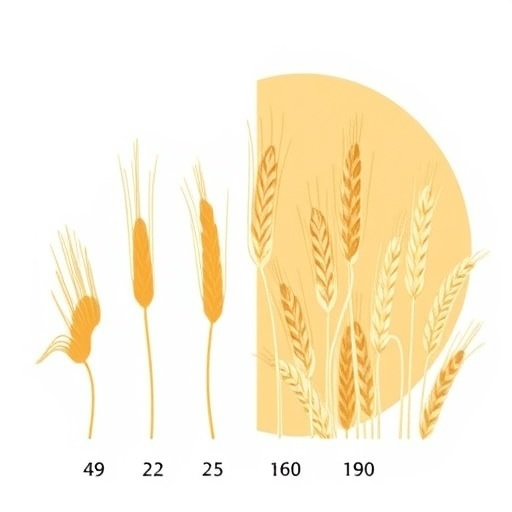In a groundbreaking study published recently, researchers have unveiled a remarkable convergence in the selection history of two of humanity’s staple cereals: wheat and barley. This discovery not only deepens our understanding of cereal crop evolution but also opens a promising path for innovative breeding strategies that could significantly enhance food security worldwide. The analysis, conducted by a multidisciplinary team led by Sow, Forestan, Pont, and colleagues, sheds new light on the parallel forces shaping these crops’ genomes despite their distinct evolutionary trajectories and domestication origins.
Wheat and barley have long stood as pillars of agricultural systems across diverse climates and cultures. Their domestication marks a pivotal moment in human civilization, enabling settled farming and surplus food production. While both crops underwent intensive selective pressures imposed by early farmers, this new research presents compelling evidence that similar selection events, targeting analogous genomic regions, occurred independently in wheat and barley lineages. The convergence is so pronounced that it reflects shared adaptive strategies employed under comparable environmental and agronomic conditions.
Using high-resolution genomic sequencing and sophisticated comparative analyses, the team identified multiple loci within wheat and barley genomes that exhibit strong signatures of positive selection. These regions are associated with critical agronomic traits such as yield stability, drought tolerance, disease resistance, and nutrient assimilation. The intersecting selection footprints highlight genetic pathways of functional importance that were recurrently shaped by domestication and subsequent breeding efforts, underscoring an evolutionary parallelism previously underestimated.
The implications of this research extend far beyond academic curiosity. Recognizing convergent evolutionary histories allows breeders to mine barley’s genetic diversity to improve wheat, and vice versa, exploiting conserved genes that govern vital traits. This cross-species perspective fosters a translational approach to crop improvement that is not confined by species boundaries but driven by common adaptive solutions. Hence, enhanced resilience to climatic stresses and better resource-use efficiency can be systematically engineered by tapping into this shared evolutionary legacy.
Moreover, the identification of these convergent selection hotspots equips geneticists with precise targets for marker-assisted selection and genome editing technologies. Gene editing tools such as CRISPR-Cas9 can be directed toward these evolutionary conserved regions to introduce beneficial alleles or disable harmful variants efficiently. Consequently, the breeding cycles can be considerably shortened, accelerating the development of high-performing cultivars suited to the challenges imposed by global climatic fluctuations and growing population demands.
The evolutionary narrative uncovered reiterates the profound interplay between natural selection and human-mediated breeding. It highlights how early farmers, albeit unintentionally, sculpted crop genomes through practices favoring traits conducive to agricultural success. This historical lens enriches our current understanding of domestication as a dynamic, ongoing process rather than a singular event confined to the distant past.
Furthermore, the comparative genomic approach adopted by Sow and colleagues sets a methodological benchmark for future studies. By integrating expansive genomic datasets from multiple cereal species, researchers can delineate universal adaptive strategies from lineage-specific innovations. This holistic perspective enables a predictive framework for identifying candidate genes instrumental in adapting crops to unforeseen agronomic challenges.
Geographically, wheat and barley were domesticated in distinct regions of the Fertile Crescent, yet their parallel adaptations underscore convergent evolution driven by similar environmental pressures such as aridity, soil quality, and pathogen exposure. This study thus contributes to the broader evolutionary theory by providing a tangible example of convergent evolution manifested at a genetic level between closely related yet independently domesticated species.
In mapping out the convergent selection patterns, the research also revisits certain classical domestication genes, confirming their central role while revealing novel loci hitherto unassociated with crop improvement traits. This dual revelation enriches the catalogue of genetic elements pivotal for breeding programs and invites further functional characterization studies to elucidate underlying molecular mechanisms.
The potential applications of these findings are timely, especially with the increasing urgency to develop sustainable agricultural systems. Combined with precision agriculture technologies, the informed manipulation of convergently selected genes could lead to cultivars optimized for reduced agrochemical inputs, enhanced yield stability, and resilience to biotic and abiotic stressors, addressing the twin challenges of environmental conservation and food production.
This landmark research, while providing a rich genomic resource, also calls for collaborative efforts integrating breeders, molecular biologists, evolutionary geneticists, and agronomists to translate these insights into tangible agronomic gains. The synergy of diverse scientific expertise will be essential to harness the full potential of convergent selection histories in crafting the next generation of wheat and barley varieties.
In summary, this study illuminates the strikingly similar selective pressures that have shaped wheat and barley genomes throughout their domestication and improvement histories. By exposing these convergent evolutionary pathways, Sow and colleagues pave the way for innovative breeding approaches aimed at maximizing crop resilience and productivity amidst the rapidly changing environmental landscape. Their work stands as a testament to the power of integrative genomics in addressing one of humanity’s most pressing challenges: securing a stable and nutritious food supply for future generations.
Subject of Research: The convergent selection history in the genomes of wheat and barley and its implications for breeding.
Article Title: Author Correction: Striking convergent selection history of wheat and barley and its potential for breeding.
Article References:
Sow, M.D., Forestan, C., Pont, C. et al. Author Correction: Striking convergent selection history of wheat and barley and its potential for breeding. Nat. Plants (2025). https://doi.org/10.1038/s41477-025-02182-8
Image Credits: AI Generated
Tags: agricultural adaptation in cerealsagronomic traits in wheat and barleycomparative genomic analysis of cropsdomestication history of wheat and barleyenvironmental impacts on cereal cropsevolutionary trajectories of staple cropsfood production and sustainability strategieshigh-resolution genomic sequencing in agricultureinnovative breeding strategies for food securitymultidisciplinary research in crop scienceshared genomic selection in cerealswheat and barley evolution






